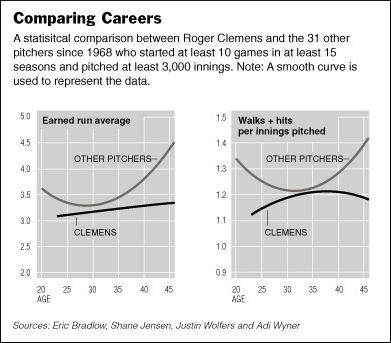Andrew had some comments about the graphs on Freakonomics that showed a seemingly odd “change of fortune” for Roger Clemens.

You can see that Clemens almost followed an opposite pattern from all other pitchers in the league. As Andrew notes though, there seems to be a lot riding on the quadratic fit and average values when we know that Clemens has been anything but ordinary throughout his long career.
Graphing Without Smoothing
For fun, I tried graphing the ERA data for Clemens against the ERAs for the 16 most recent hall of fame pitchers (that I could get data for). My thinking was the hall-of-famer performances might be a better indicator of what should be “normal” for great pitchers. The results are a little less compelling. However, one thing to note is that most players who played past age 40 saw an increase in ERA while Clemens had a pretty significant improvement in ERA from age 40 to 43.
Whether this is due to performance enhancing drugs or just a change in pitching strategy, coaching, or some other factor, I can’t say. There’s probably only a few people who can know for sure.
Anyways, if anyone has a different take on the data, I’d love to hear it in the comments.


Is there some evidence to believe that no previous pitcher has taken performance enhancing drugs? ;)
You might try looking at walk to strikeout ratio, as that’s the only statistic that the pitcher truly has control over. He may have had a less hitter-friendly park in Houston for his low ERA, may have had better defense behind him, or simply could have had outstanding luck that season.
@hadley: i guess not. i just didn’t want a big, gray and non-interactive blobby.
@dave: One interesting note — Clemens’ ERA improvement, that started at age 40, spans across play with the Yankees and the Astros. You do bring up a good point though, and strikeout ratio is definitely worth investigating. Maybe someone would like to give that a try.
I was talking with a baseball mad friend who loves Roger Clemens yesterday about this. We were discussing the “hall of fame” effect on his pitching in later years.
Given that all of his managers want him to get into the hall of fame they might pull him early if it looks like his stats will take a hit (no pun intended). Would this effect the numbers that much?
Clemens played fewer innings the past two seasons than any other season in his career, but could it be just because he’s getting older and doesn’t heal as quickly?
Clemens’ inning counts were low lately because missed some starts in recent seasons for injuries, and last year he waited until after the season started to decide whether to play, and didn’t even start pitching until June or so.
I saw an alternative analysis of Clemens’ stats, which took into account walks, strikeouts, and home runs, either on the Freakonomics blog or on a page they cited. I can’t find it now, because the blog isn’t answering my browser.
Nathan: Can you provide the list of the 16 most recent HOF pitchers that you used for your comparison? If you have their baseball-databank IDs, that would be even better, but not necessary.
One thing to note is that the allegations of Clemens’ steroid use go back to at least 1998, which covers some of the highest as well as the lowest ERAs of his career.
Well…
ERA is a flawed measure.
It measures defense and luck more than pitching skill, for one. It measures context as much as it does the pitcher. And it conveniently elides durability.
As an object lesson, take Carlton’s last season (which baseball-reference has as age-43) in 1988. He got a grand 29 outs, more telling by far than his awful performance. Clemens’s 2005, he essayed 634 outs, and put in his yeoman’s effort in a half-run-per-game higher-ERA environment.
If you must use ERA, try b-r’s ERA+ measure. ‘Tain’t perfect, but it isn’t bad.
wcw, i think you’re right about ERA being flawed, which is interesting, because ERA is so often quoted as if it were a performance measure. i wonder if it’s just b/c it’s easiest for the most people to understand.